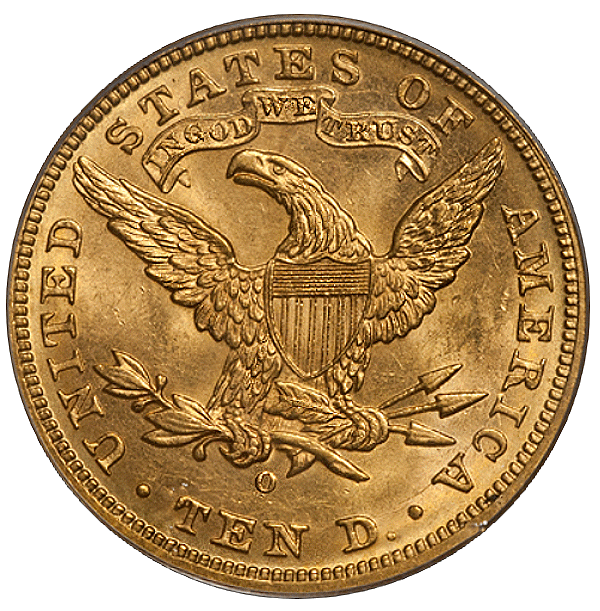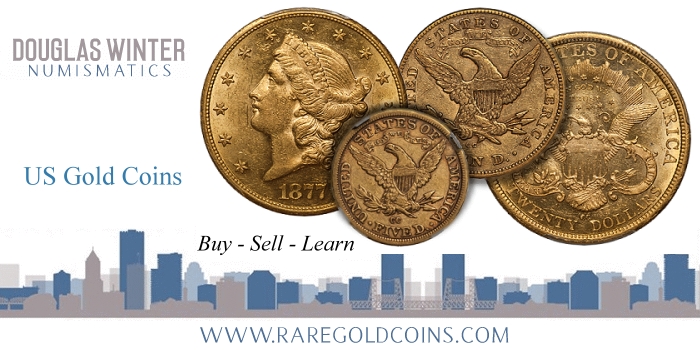
By Doug Winter – RareGoldcoins.com
CoinWeek Content Partner ……
Earlier this fall I wrote the first part of this article, which discussed the No Motto eagles from the New Orleans mint. (You can find the full article here.) This second part focuses on the With Motto eagles from the Crescent City.
Production of eagles at the New Orleans mint ended in 1860 and did not resume until the mint was reopened in 1879. During this year, only three denominations were produced: silver dollars, eagles and double eagles.
The 16 issues which form this set are all members of the With Motto type which lasted on this design from 1866 through its discontinuation in 1907. The dates range from common to very rare. If a few issues are not included, it is possible for the collector of average means to assemble a very nice set for an average of $1,500-2,000 per coin.
The following chart shows the PCGS and NGC populations figures for the With Motto New Orleans eagles. After you glimpse at these figures, let’s explore the coins on a date by date basis.
|
YEAR |
PCGS Pop |
NGC Pop |
Total |
| 1879-O |
43 |
46 |
89 |
| 1880-O |
173 |
179 |
352 |
| 1881-O |
131 |
189 |
320 |
| 1882-O |
172 |
191 |
363 |
| 1883-O |
29 |
19 |
48 |
| 1888-O |
490 |
614 |
1104 |
| 1892-O |
588 |
697 |
1285 |
| 1893-O |
469 |
424 |
893 |
| 1894-O |
504 |
862 |
1366 |
| 1895-O |
531 |
702 |
1233 |
| 1897-O |
300 |
384 |
684 |
| 1899-O |
247 |
232 |
479 |
| 1901-O |
461 |
434 |
895 |
| 1903-O |
1070 |
1138 |
2208 |
| 1904-O |
656 |
646 |
1302 |
| 1906-O |
326 |
348 |
674 |
Let’s take a date-by-date look at each of the No Motto eagles made by the New Orleans mint.
1879-O:
This is a numismatically significant issue as the first O mint ten struck with the With Motto type reverse. Only 1,500 were struck, and it is well-known as a rarity with fewer than 100 coins. This date is almost never seen in grades below EF45 and is excessively rare in Uncirculated with just two known (a PCGS MS61 I sold to a New England collector in 2014 and an NGC 61 I sold in 2007). The typical 1879-O eagle grades AU50 to AU55 and is characterized by exceedingly bagmarked surfaces. The natural color is a distinctive orange-gold with rose shadings, and I have seen but a few which were not dipped or processed.
The last two AU58 coins that I was offered were grossly overpriced as the dealers offering them misinterpreted the $64,625 APR achieved by HA 1/14: 5499. This coin, housed in an old NGC holder and later upgraded to PCGS MS61, was by far the finest I had ever seen in a “58” holder and other bidders agreed. A “typical” AU58 is worth more like half the amount this coin brought.
Overall Rarity Ranking: 2nd of 16
1880-O:
The 1880-O begins a three-year run of limited production New Orleans eagles. The 1880-O is a touch less available than the 1881-O but it is scarcer than the 1882-O. Of the 9,200 struck, around 250-300 are known with most in the EF45 to AU53 range. Nice About Uncirculated 1880-O eagles are scarce, and this date is rare in properly graded AU58. In Uncirculated, the 1880-O is extremely rare with five or six known to me. This includes a piece in the Smithsonian/NNC collection which I grade MS64 and an NGC MS64. Most 1880-O eagles are very heavily abraded and have been dipped or lightened. Pieces with natural color and good luster do exist but these are hard to find.
At one point, a collector in New York was hoarding this date and I believe that he owned a significant number of pieces in the EF-AU range, as well as the finest known (NGC MS64). I don’t know if he still has his position or if they have been quietly absorbed into the market.
Overall Rarity Ranking: 4th of 16
1881-O:
The 1881-O is, by a small margin, the scarcest of the three low-mintage New Orleans eagles made between 1880 and 1882. Only 8,350 were struck, and I estimate that 225-275 are known today, mostly in lower grades. The 1881-O is harder to locate in choice condition than the 1880-O, and AU55 is about the highest grade seen with any regularity. Properly graded AU58’s are rare and the 1881-O is a very rare coin in Uncirculated, with five or six known but none above the MS60 to MS61 range.
The true rarity of this date in Uncirculated has finally been recognized by specialists. Heritage 2015 ANA: 6249, graded MS60 by PCGS and very heavily abraded (but truly “new”) sold for a strong $14,100; about $4,000 to $5,000 more than I had expected.
Overall Rarity Ranking: 3rd of 16
1882-O:
For the first time since re-opening in 1879, the New Orleans mint actually struck more than 10,000 eagles in a single year in 1882. There are an estimated 300-350 known, mostly in the EF40 to AU53 range. As with its counterparts the 1880-O and the 1881-O, this is an issue with real eye appeal problems. Most pieces are excessively abraded and lack original color. This is sometimes compounded by planchet issues and/or weakness of strike. An 1882-O with original color and surfaces is scarce in any grade and this date is very hard to find above AU55. Uncirculated examples are rare with an estimated nine or ten known, mostly in the MS60 to MS61 range. The finest known are a pair of PCGS MS63 coins, both of which I have handled (one in 2007 and the other in late 2014).
Overall Rarity Ranking: 5th of 16
1883-O:
With a mintage of just 800 coins, this issue has the lowest production figure of any gold coin struck at this mint. For many years, the 1883-O was a grossly undervalued coin. This changed around seven years ago, when I sold the finest known (a PCGS 61) to a dealer/collector for a six figure price. From then on, prices for all 1883-O eagles shot up; certainly to the point where this issue is no longer “clearly undervalued” as I wrote when I published the second edition of my New Orleans gold book in 2006.
There are an estimated 45-55 known with around a dozen in the various Uncirculated grades, and two in Uncirculated (one PCGS MS61 and one NGC MS61). This date is not often seen with good eye appeal, and most survivors are weakly impressed at the obverse border and heavily abraded in the fields. Coins with natural color and choice surfaces are very rare.
Overall Rarity Ranking: 1st of 16
1888-O:
After a four-year hiatus, production of New Orleans eagles resumed in 1888. From here on out, these issues have a totally different rarity profile than the 1879-1883 New Orleans eagles. Part of this has to do with larger mintages, but the main reason is that these later dates tended not to circulate and were used mainly to make foreign trade payments, and shipped overseas.
The 1888-O is seen most often in AU58 to MS61 grades. It is moderately scarce in MS62, very scarce in properly graded MS63, and extremely rare in MS64. To date, the only example graded MS64 is ex Stacks Bowers 2013 ANA: 4518 at $21,150. Most 1888-O eagles are very baggy and many are soft on the radial lines in the stars.
Overall Rarity Ranking: 10th of 16
1892-O:
The 1892-O is a bit more available than the 1888-O and it has a similar rarity profile. It is almost never seen below AU55 to AU58, and most of the Uncirculated coins known fall into the MS60 to MS62 range. Properly graded MS63s are very rare with an estimated half dozen or so known. The finest 1892-O eagle I have seen is the PCGS MS63+ from the Simpson/Hall collection.
This date is typically a bit weakly struck on the obverse and nearly always very heavily bagmarked on both sides. Collectors who hate baggy coins are going to have problems finding late date New Orleans eagles which meet their standards. Moderately abraded coins do exist, but they are really hard to locate.
Overall Rarity Ranking: 13th of 16
1893-O:
The 1893-O eagle is scarcer than the 1888-O and the 1892-O. It is another date which is rarely seen in circulated grades, and mostly in the MS60 to MS62 range. A dozen or possibly a few more exist in MS63 with none finer. None of the MS63’s which I have seen (or owned) stand out as being distinctly the finest known.
Many of the nicer Uncirculated 1893-O eagles on the market come from Europe and these tend to show deep orange-gold color with contrasting hues on the relief details. I’ve never seen an 1893-O eagle which wasn’t abraded to some extent. At $4,000-5,000, I think a properly graded MS63 is good value.
Overall Rarity Ranking: 9th of 16
1894-O:
Two decades ago, this date was seldom seen in any grade but it is now plentiful due to European hoards. It is easily located in MS60 to MS61 and it is only marginally scarce in MS62 although examples in this grade with CAC approval are hard to find. The 1894-O is rare in MS63 and very rare above this. Unlike the 1892-O and 1893-O, a few really nice pieces exist including an NGC MS65 (ex ANR 9/05: 1319) and a single MS64 at PCGS.
This date is seen in circulated grades and may have actually seen commercial use unlike the 1888-O, 1892-O, and 1893-O. It is often very heavily abraded but it tends to show good luster, strong details, and original pieces are nicely toned.
Overall Rarity Ranking: 12th of 16
1895-O:
The 1895-O is similar in overall rarity to the 1894-O but it is seen a bit more often in MS63. It should be noted that many of the coins in MS63 holders have “gradeflated” from MS62 and are not choice. I have never seen or heard of one above this level.
Most 1895-O eagles are very heavily abraded and have impaired luster as a result. Original pieces may have good coloration. In terms of CAC quality pieces, MS62 is about as nice as this issue is found.
Overall Rarity Ranking: 11th of 16
1897-O:
The mintage of this date is around half as much as the 1895-O and, as a result, it is a scarce coin. The 1897-O is not hard to locate in MS60 to MS61, but it is scarce in MS62 and very scarce in properly graded MS63. Around a half dozen are known in MS64, and there are at least two amazing Superb Gems known, one in PCGS MS66 and another in PCGS MS67.
The 1897-O tends to a have a different appearance than these preceding five dates with softer, more “creamy” luster and lighter natural color. It is possible to find a piece which is not riddled with marks, but really choice MS64 examples do not become available very often; expect to pay in the $12,500-15,000 range for one.
Overall Rarity Ranking: 8th of 16
1899-O:
The 1899-O is the scarcest New Orleans eagle from this decade. I believe there are 300-400 known, mostly in the AU55 to MS61 range. This date is scarce in MS62 (especially if properly graded), rare in MS63, and very rare in MS64 with four known to me.
There is one amazing 1899-O eagle known which is currently in a PCGS MS68+ holder. It was obtained by John Clapp Sr. from the New Orleans mint at the time of issue and later was owned by Louis Eliasberg. It is currently owned by Texas collector Bob Simpson, and it is the single finest New Orleans gold coin known.
Overall Rarity Ranking: 6th of 16
1901-O: The 1901-O is generally priced similarly to the 1903-O and 1904-O but it is a scarcer issue. It is easy to find in circulated grades and is common in MS60 to MS62. Properly graded MS63’s, which have dropped appreciably in price, seem to be good values at their current $2,750-3,250 level. Around a dozen MS64’s are known as well as a single PCGS MS66 which is ex Clapp/Eliasberg.
Overall Rarity Ranking: 14th of 16
1903-O:
The 1903-O is the most common New Orleans eagle. Examples are still being found in Europe and this date is plentiful in the lower Uncirculated grades. MS63’s are not really scarce but this date is hard to find in properly graded MS64. Such coins currently are valued in the $4,000-5,000 range and are always in demand as type examples from this mint. I am aware of two Gems: an NGC MS65 which sold for $16,100 in May 2007, and the Clapp/Eliasberg MS66 which has been off the market for years.
Overall Rarity Ranking: 16th of 16
1904-O:
The next most common New Orleans eagle is the 1904-O. This is another date which is still being found overseas, albeit in the AU55 to MS61 range. The 1904-O is common in MS62 and available in MS63. It becomes very scarce in full MS64 and it is a good value at current levels. Around a half dozen gems are known as well as two superb pieces: a PCGS MS67, and an NGC MS68 which is a possible specimen strike.
Overall Rarity Ranking: 15th of 16
1906-O:
While similar in original mintage to the 1903-O and 1904-O, the 1906-O is about twice as scarce as these two dates. This is either due to many having been melted or quantities exist overseas awaiting discovery and repatriation. The 1906-O is not often seen above MS62 and there are likely not more than a dozen or so known in MS64. I believe that around five or six Gems are known including two MS66’s at both NGC and PCGS.
Overall Rarity Ranking: 7th of 16
I have assembled many sets of With Motto New Orleans eagles for collectors and these are generally much easier to complete than the No Motto eagles from this mint. There are two genuinely rare coins (the 1879-O and the 1883-O) in the With Motto set but the other dates are obtainable. Most collectors look for the 1880 through 1882 issues in nice AU and they buy the other, more common dates in the best sensible grade(s); usually MS62 to MS64.

About Doug Winter
 Doug has spent much of his life in the field of numismatics; beginning collecting coins at the age of seven, and by the time he was ten years old, buying and selling coins at conventions in the New York City area.
Doug has spent much of his life in the field of numismatics; beginning collecting coins at the age of seven, and by the time he was ten years old, buying and selling coins at conventions in the New York City area.
In 1989, he founded Douglas Winter Numismatics, and his firm specializes in buying and selling choice and rare United States coins, especially US gold coins and all branch mint material.
Recognized as one of the leading specialized numismatic firms, Doug is an award winning author of over a dozen numismatic books and the recognized expert on US Gold. His knowledge and exceptional eye for properly graded and original coins has made him one of the most respected figures in the numismatic community and a sought after dealer by collectors and investors looking for professional personalized service, a select inventory of impeccable quality and fair and honest pricing. Doug is also a major buyer of all US coins and is always looking to purchase collections both large and small. He can be reached at 214-675-9897.
Doug has been a contributor to the Guidebook of United States Coins (also known as the “Redbook”) since 1983, Walter Breen’s Encyclopedia of United States and Colonial Coins, Q. David Bowers’ Encyclopedia of United States Silver Dollars and Andrew Pollock’s United States Pattern and Related Issues
In addition he has authored 13 books on US Gold coins including:
- Gold Coins of the New Orleans Mint: 1839-1909
- Gold Coins of the Carson City Mint: 1870 – 1893
- Gold Coins of the Charlotte Mint: 1838-1861
- Gold Coins of the Dahlonega Mint 1838-1861
- The United States $3 Gold Pieces 1854-1889
- Carson City Gold Coinage 1870-1893: A Rarity and Condition Census Update
- An Insider’s Guide to Collecting Type One Double Eagles
- The Connoisseur’s Guide to United States Gold Coins
- A Collector’s Guide To Indian Head Quarter Eagles
- The Acadiana Collection of New Orleans Coinage
- Type Three Double Eagles, 1877-1907: A Numismatic History and Analysis
- Gold Coins of the Dahlonega Mint, 1838-1861: A Numismatic History and Analysis
- Type Two Double Eagles, 1866-1876: A Numismatic History and Analysis
Finally Doug is a member of virtually every major numismatic organization, professional trade group and major coin association in the US.
If you are interested in buying or selling classic US coins or if you would like to have the world’s leading expert work with you assembling a set of coins? Contact Doug Winter at (214) 675-9897 or by email at [email protected].




